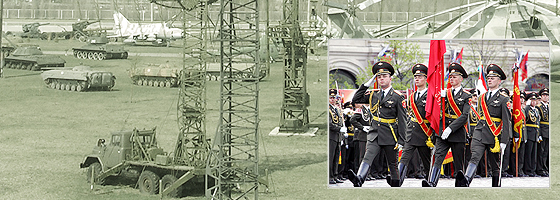Russian Armed Forces - Overview
The Armed Forces of the Russian Federation are a state military organization intended to repel aggression directed against Russia, to protect the country’s territorial integrity, as well as to fulfill tasks in accordance with international treaties. The Supreme Commander-in-Chief is the President of the Russian Federation.
The Armed Forces of Russia were established on the basis of the former Armed Forces of the USSR (2,880,000 people) on May 7, 1992. In 2017, the total number of military personnel was about 1,000,000 people.
Military service in the Armed Forces of Russia is provided for both under the contract and by conscription. The overwhelming majority of military personnel are men. There are about 50,000 women in military service.
Russian Armed Forces - Composition
Russia possesses the world’s largest stockpile of nuclear weapons and the second largest group of strategic carriers of nuclear weapons after the United States. Strategic nuclear forces of Russia are distributed in the so-called nuclear triad: intercontinental ballistic missiles, submarine-launched ballistic missiles and strategic bombers.
The Land Forces of Russia:
- Motorized infantry equipped with infantry fighting vehicles, armored personnel carriers, trucks,
- Tank forces - the main strike force,
- Missile forces and artillery,
- Air defense forces,
- Special forces and services (radiation, chemical and biological protection, engineer troops, communications troops, etc.).
The Air Forces of Russia:
- Long-range aviation,
- Frontline aviation,
- Army aviation,
- Military transport aviation,
- Special aviation,
- Anti-aircraft missile forces,
- Radio technical troops.
The Navy of Russia consists of the Baltic, Northern, Pacific, Black Sea fleets, the Caspian flotilla and includes:
- Underwater forces,
- Surface forces,
- Naval aviation,
- Coastal troops (Marine corps and Coastal missile-artillery forces),
- Special forces of the Navy.
Strategic Missile Forces, armed with intercontinental ballistic missiles with nuclear warheads, are the main component of Russia’s strategic nuclear forces.
The Airborne Forces carry out operational landing and conduct combat operations behind enemy lines.
The Armed Forces of the Russian Federation are territorially divided between five military districts:
- Western Military District (St. Petersburg),
- Northern Fleet (Severomorsk),
- Southern Military District (Rostov-on-Don),
- Central Military District (Yekaterinburg),
- Eastern Military District (Khabarovsk).
Russian Armed Forces - Equipment and Armaments
Traditionally, since the middle of the 20th century, the Soviet Armed Forces almost completely lacked foreign military equipment and armaments, with rare exceptions (individual products of the socialist countries). In the USSR, completely self-sufficient military production was created, which was capable of producing any armament and equipment for the needs of the armed forces.
During the Cold War, its gradual accumulation took place, and, by 1990, the amount of armaments in the Soviet Armed Forces reached unprecedented levels. Only in the land forces there were about 63,000 tanks, 86,000 infantry and armored vehicles, 42,000 artillery barrels. A significant part of these stockpiles was transferred to the Armed Forces of the Russian Federation and other republics of the former USSR.
The Land Forces of Russia are armed with:
- Tanks T-72, T-80 and T-90,
- Infantry fighting vehicles BMP-1, BMP-2, BMP-3,
- Airborne infantry fighting vehicle BMD-1, BMD-2, BMD-3, BMD-4M,
- Armored personnel carriers BTR-70, BTR-80, BTR-82,
- Armored vehicles GAZ-2975 “Tiger”,
- Self-propelled and towed barrel artillery,
- Rocket fire systems Grad, Hurricane, Tornado, Buratino, Solntsepek,
- Tactical missile systems Tochka and Iskander,
- Air defense systems Buk, Tor, Pantsir-S1, S-300, S-400.
The Air Forces of Russia are armed with:
- Fighters MiG-29, MiG-31, Su-27, Su-30, Su-35,
- Front-line bombers Su-24 and Su-34,
- Attack aircraft Su-25,
- Long-range and strategic bombers-missile carriers Tu-22M3, Tu-95, Tu-160,
- Military transport aircraft An-22, An-72, An-124, Il-76,
- Special aircraft - air tanker IL-78, air command posts IL-80 and IL-96-300PU, long-range radar detection aircraft A-50,
- Combat helicopters Mi-8, Mi-24, Mi-35M, Mi-28N, Ka-50, Ka-52,
- S-300 and S-400 surface-to-air missile systems.



The comments of our visitors